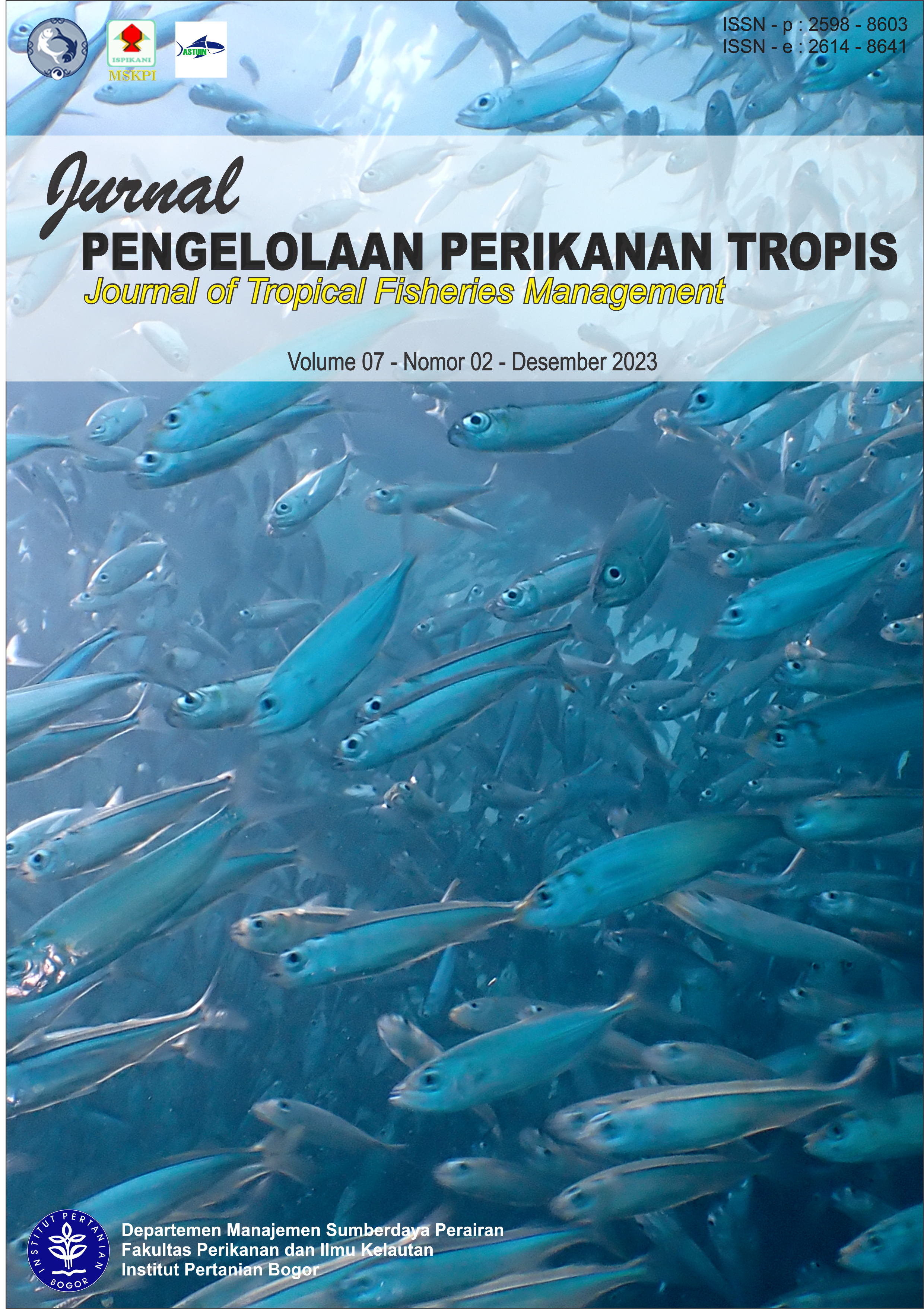Sustainability Status Analysis of Seaweed Cultivation (Eucheuma cottonii) in Barru Regency: Rap-Seaweed Modification Method
Analisis Status Keberlanjutan Budidaya Rumput Laut (Eucheuma cottonii) di Kabupaten Barru: Metode Modifikasi Rap-Seaweed
Abstract
Barru Regency is one of the largest seaweed producing areas in South Sulawesi. The sustainability of seaweed cultivation is influenced by various factors, including ecological, economic, social, institutional and technological. This study aims to analyze sustainability status of seaweed cultivation in Barru Regency. The method used is Multidimensional Scaling (MDS) approach which is analyzed by RAP SEAWEED. Several parameters from each dimension were analyzed to assess existing condition of seaweed cultivation in Barru Regency. The results showed that seaweed cultivation in Barru Regency was classified as quite sustainable on social and technological dimensions and was classified as less sustainable on institutional, economic and ecological dimensions. Parameter analysis using stress, R-Square, and monte carlo values shows accuracy of model and attributes are feasible for use in analysis. The results of sustainability status analysis which are still classified as lacking need to be addressed by taking into account several attributes that have high sensitivity in leverage analysis. Evaluation of attributes for increasing sustainability score can be a basic consideration in formulating a strategy for sustainable management of seaweed cultivation in Barru Regency
Downloads
References
Alder J, Pitcher TJ, Preikshot Dkaschner K, & Ferriss B. 2000. How good is good? A rapid appraisal technique for evaluation of the sustainability status of fisheries of the North Atlantic. In Methods for evaluating the impacts of fisheries on North Atlantic ecosystems. University of British Columbia, Canada, ed. D. Pauley and T. J. Pitcher. Fisheries Centre Research Reports 8(2):136–182.
Arsyad M, Nuddin A, Zamhuri MY, & Yusuf S. 2014. The poverty reality of coastal and agriculture: how severe the seaweed farmers and cocoa smallholders are?. International Journal of Agriculture System. 2(2): 119-31.
Aslan LOM, Nur IW, Siti AAT , Manat R, Ruslaini, & Wa Ode S. 2022. The debt trap of seaweed farmers: a case study from Bajo Community in Bungin Permai, Indonesia. IOP Conf. Ser.: Earth Environ. Sci. 1033: 012056.
Bae SH, Qiu J, Fox G. 2012. Adaptive interpolation of multidimensional scalling. Procedia Computer Science. 9: 393-402. doi: 10.1016/j.procs.2012.04.042.
Duarte CM, Bruhn A, & Krause-Jensen DA. 2022. Seaweed aquaculture imperative to meet global sustainability targets. Nat Sustain. 5: 185–193. https://doi.org/10.1038/s41893-021-00773-9.
Fauzi A, Anna S. 2005. Pemodelan Sumberdaya Perikanan dan Kelautan : untuk Analisis Kebijakan. Jakarta : PT. Gramedia Pustaka Utama.
Hasselström L, Wouter V, Fredrik G, Göran MN, Henrik P. 2018. The Impact of Seaweed Cultivation on Ecosystem Services – a case study from the west coast of Sweden. Marine Pollution Bulletin. 133: 53-64. https://doi.org/10.1016/j.marpolbul.2018.05.005.
Hasyim AW, Paembonan RE. 2017. Sustainable resource development in the province of small island’s North Maluku (case Moti island). International Journal of Economic Research. 14(7): 293-310.
Kambey CSB, Iona C, Calvyn FAS, Adibi RMN, Phaik EL, & Elizabeth JCC. 2020. An analysis of the current status and future of biosecurity frameworks for the Indonesian seaweed industry. Journal of Applied Phycology. 32: 2147–2160. https://doi.org/10.1007/s10811-019-02020-3.
Kavanagh P, Pitcher TJ. 2004. Implementing Microsoft Excel Software For Rapfish: A Technique for The Rapid Appraisal of Fisheries Status. University of British Columbia, Fisheries Centre Research Reports. 12(2): 75 p.
Kementerian Kelautan dan Perikanan. 2018. Produktivitas Perikanan Indonesia. Jakarta (ID): KKP
Kusman. 2019. Sistem Pengetahuan Petani Rumput Laut di Desa Gonebalo Kecamatan Duruka Kabupaten Muna. Sosial dan Budaya. 8 (1): 64 – 71.
Larson S, Stoeckl N, Fachry ME, Dalvi M, Lapong M, Purnomo I, Rimmer AH, Paul NA. 2021. Women’s well-being and household benefits from seaweed farming in Indonesia. Aquaculture. 530: 735711.
Pitcher TJ, Preikshot D. 2001. RAPFISH: a rapid appraisal technique to evaluate the sustainability status of fisheries. Fisheries Research. 49: 255-270. doi: S0165-7836(00)00205-8.
Purnomo AH, Subaryono, Utomo BSB, & Paul N. 2020. Institutional arrangement for quality improvement of the Indonesian Gracilaria seaweed. AACL Bioflux. 13(5): 2798-2806.
Shah B, Khanzode V. 2017. A Comprehensive review of warehouse operational issues. International Journal of Logistics Systems and Management. 26(3):346-378.
Valderrama D, Cai J, Hishamunda N, & Ridler N. 2015. The economics of Kappaphycus Seaweed Cultivation in developing countries: a comparative analysis farming systems. Aquaculture Economics & Management. 19(2): 251-277. doi:10.1080/13657305.2015.1024348.
Wijayanto D, Faik K, & Ristiaawan AN. 2022. A study on the socio-economic characteristics of seaweed farmers on Kemojan Island to support the conservation in Karimunjawa Marine Protected Area. AACL Bioflux. 15(5): 2638-2650.
Yong WTL, Ting SH, Yong YS, Thien VY, Wong SH, Chin GJWL, Rodrigues KF, & Anton A. 2013. Optimization of culture conditions for the direct regeneration of Kappaphycus alvarezii (Rhodophyta, Solieriaceae). Journal of Applied Phycology. 26(3): 1-13. doi:10.1007/s10811-013-0191-4.
Zamroni A, Yamao M. 2012. An assessment of farm-to-market link of Indonesian dried seaweeds: Contribution of middlemen toward sustainable livelihood of small-scale fishermen in Laikang Bay. Afr. J. Agric. Res. 7: 4198–4208
Copyright (c) 2024 Journal of Tropical Fisheries Management

This work is licensed under a Creative Commons Attribution 4.0 International License.
After the article is submitted and published in this journal, it is fully copyrighted by the Journal of Tropical Fisheries Management. If excerpts from other copyrighted works are included, authors must obtain written permission from the copyright owner and give credit to the source in the article. Then, authors or reader is allowed to copy, share, and redistribute articles/material in any form. But it must still include the appropriate source and credit because the article in this journal is licensed by Creative Commons Attribution 4.0 International License (CC BY 4.0).



1.png)
1.png)








